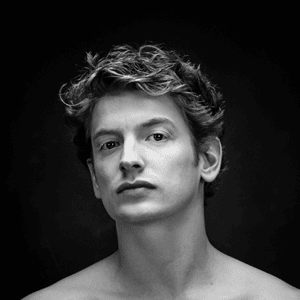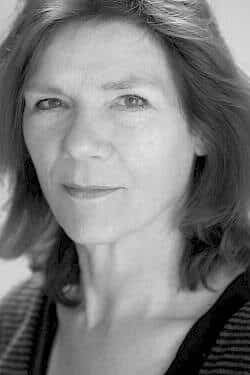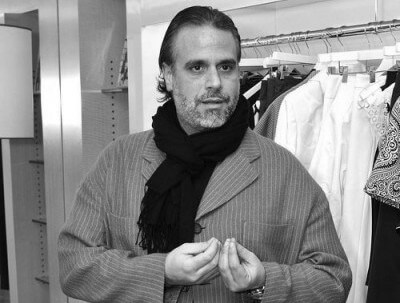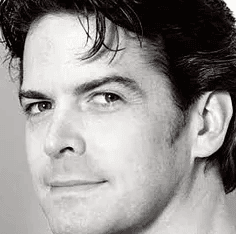
Born in Prague in 1947, Jiří Kylián started his dance training when he was nine years old at the ballet school of the Prague National Theatre. From the age of fifteen he studied at the Prague Conservatory. In 1967 Kylián went to the Royal Ballet School in London with a scholarship of the British Council. Here he came into contact with the most important developments in choreography – ballet as well as contemporary dance. Consequently, John Cranko, a major choreographer of this period and director of the Stuttgart Ballet, offered him a dancer’s contract and encouraged Kylián’s ambition to create his own dance works. In 1973, following a first choreography for Nederlands Dans Theater, an artistic relationship between Kylián and the well-known Dutch company began which brought about the creation of almost 50 dance productions for this group. From 1975 on, Kylián is responsible for NDT’s artistic policy. 1978 brought a decisive international break-through with Sinfonietta, his choreography to the music of compatriot Leoš Janáček at the U.S. Spoleto Festival in Charleston N.C. After 1978, Charleston established Kylián’s reputation as one of the most ingenious choreographers with dance works such as Symphony of Psalms, Forgotten Land, Overgrown Path, Svadebka, Stamping Ground, L’Enfant et les Sortileges, to name only a few.
Since the mid eighties, Kylián’s artistic view and style have changed considerably towards abstraction and surrealistic images, examples begin with his Black and White Program, with works such as No More Play, Petite Mort, Sarabande, Falling Angels, Sweet Dreams, Whereabouts Unknown, or his dance production reflecting on a Japanese fairy tale entitled Kaguyahime. Having created a unique and very personal style in the course of the years, Kylián’s choreographies defy academic categorization, blending elements of many sources. There are always new inspirations to be explored, new challenges and boundaries to be overcome. Profoundly based on musical reading, there is something in his work deeply penetrating into the mystery of the human being itself, unveiling hidden traces through his dance. For 20 years now, Kylián’s artistic vision has blended with the image of Nederlands Dans Theater into a unique symbiosis. Today, the world famous main group (NDT 1) is complemented by a young, experimental company of 17 – 22 year old dancers (NDT 2), and a group of mature dancers/performing artists past the age of 40 (NDT 3), each of which has its own repertoire reflecting the specific qualities of a certain lifetime. Together, they constitute the organization called Nederlands Dans Theater: “Three dimensions of a dancer’s life”, as Jiří Kylián likes to refer to them. In April 1995, NDT celebrated its 35th anniversary and Kylián’s 20 years of artistic directorship with the big theatrical production Arcimboldo in which NDT-1, NDT-2 and NDT-3 participated. On April 13, Jiří Kylián was honored with the Dutch “Orde van Oranje Nassau” by Queen Beatrix of the Netherlands for his complete choreographical work and his contribution to Dutch dance. In 1999, Kylián passed the artistic direction to the new generation. He stays connected to the company as a choreographer . In the years between 1973 and today, he has created 72 ballets for NDT. His entire body of work counts 92 creations. Besides creating for NDT, Kylián has made original works for the Stuttgart Ballet, Paris Opera, Swedish Television and the Tokyo Ballet. He has worked with many creative personalities of international stature – composers: Arne Nordheim (Ariadne 1997), Toru Takemitsu (Dream Time 1983) – designers: Walter Nobbe (Sinfonietta 1978), Bill Katz (Symphony of Psalms 1978), John Macfarlane (Forgotten Land 1980), Michael Simon (Stepping Stones1991), Atsushi Kitagawara (One of a Kind 1998), and Susumu Shingu (Toss of a Dice 2005). In the Summer of 2006, together with regisseur Boris Paval Comen, Kylián created a film entitled CAR-MEN. It was choreographed “on location” in the surface brown coal mines of the Czech Republic. In the course of his career, Kylián has received many international awards including Officer of the Orange Order – Netherlands, an Honorary Doctorate from The Juilliard School, three Nijinsky Awards – Monte Carlo (best choreography, company and work), Benoit de la Danse – Moscow and Berlin, Honorary Medal of the President of the Czech Republic, Commander of the Legion d’honneur – France, and many others. Kylián’s creations are danced by more than 80 companies and schools worldwide.
Andrea Miller, Artistic Director and choreographer of Brooklyn-based company, GALLIM, has established herself as a perpetually groundbreaking artist who brings unbridled empathy, intimacy, and sensitivity to her work. A sought-after creator and collaborator in dance, film, theater, tech, and fashion, Miller was named 2017/2018 Artist in Residence at The Metropolitan Museum of Art, becoming the first choreographer to hold that distinction. Miller’s residency opened with Stone Skipping, named 2017 Best Choreography by Wendy Perron, Dance Magazine, a site responsive work for The Temple of Dendur. Miller culminates the residency with an installation at The Met Breuer (May 2018).

Russell Ducker began his training in 2000 at the Royal Ballet Lower School, White Lodge and graduated from the Royal Ballet Upper School, Covent Garden in 2007. In 2006, he won the Pamela Self Award for dance, as well as a bursary from the NFL foundation. While in school, Russell performed with the Royal Ballet in their productions of Swan Lake, Onegin, The Nutcracker (Fritz), as well as the Anthony Dowell Celebration Gala. Russell joined Philadelphia Ballet as a member of the corps de ballet for our 2014/2015 season and has since danced in a range of classical and contemporary works, including Christopher Wheeldon’s Swan Lake and DGV: Danse à Grande Vitesse, Larry Keigwin’s Canvas, David Dawson’s The Third Light, and Nacho Duato’s Without Words and Remansos.
Prior to Philadelphia Ballet, Russell performed with Angel Corella and Friends. He later joined Angel Corella’s Barcelona Ballet, where he danced various soloist and principal roles and accompanied them in touring engagements to Houston, Los Angeles, New Orleans, New York, Santa Barbara, Seattle, Buenos Aires, Portugal, and France. Russell also choreographed several ballets for the company, many of which enjoyed international premieres. As a choreographer, Russell has received awards in the Dame Ninette De Valois, Sir Kenneth MacMillan, and Ursula Moreton choreographic competitions and was chosen in 2006 to collaborate with musicians from the Royal College of Music in creating a new choreography. Russell’s choreography with Barcelona Ballet includes Built to Fall Apart, Argon, Bourbon Street, The Fall, Suspended in Time, Epimetheus, and In the Wake of Bliss. Russell has been featured in numerous television commercials, including one with premiere league footballer Neymar da Silva, and he has performed alongside Hugh Jackman and Maureen Lipman in Cameron Mackintosh’s West End production of Oklahoma.
Born on January 27, 1756, in Salzburg, Austria, Wolfgang Amadeus Mozart was a musician capable of playing multiple instruments who started playing in public at the age of 6. Over the years, Mozart aligned himself with a variety of European venues and patrons, composing hundreds of works that included sonatas, symphonies, masses, chamber music, concertos and operas, marked by vivid emotion and sophisticated textures.
Wolfgang Amadeus Mozart’s was the sole-surviving son of Leopold and Maria Pertl Mozart. Leopold was a successful composer, violinist, and assistant concert master at the Salzburg court. Wolfgang’s mother, Anna Maria Pertl, was born to a middle class family of local community leaders. His only sister was Maria Anna (nicknamed “Nannerl”). With their father’s encouragement and guidance, they both were introduced to music at an early age. Leopold started Nannerl on keyboard when she was seven, as three-year old Wolfgang looked on. Mimicking her playing, Wolfgang quickly began to show a strong understanding of chords, tonality, and tempo. Soon, he too was being tutored by his father.
In 1762, Wolfgang’s father took Nannerl, now age eleven, and Wolfgang, age six to the court of Bavaria in Munich in what was to become the first of several European “tours.” The siblings traveled to the courts of Paris, London, The Hague, and Zurich performing as child prodigies. Wolfgang met a number of accomplished musicians and became familiar with their works. Particularity important was his meeting with Johann Christian Bach (Johann Sebastian Bach’s youngest son) in London who had a strong influence on Wolfgang. The trips were long and often arduous, traveling in primitive conditions and waiting for invitations and reimbursements from the nobility. Frequently, Wolfgang and other members of his family fell seriously ill and had to limit their performance schedule.
In December, 1769, Wolfgang, then age 13, and his father departed from Salzburg for Italy, leaving his mother and sister at home. The Italian outing was longer than the others (1769-1771) as Leopold wanted to display his son’s abilities as a performer and composer to as many new audiences as possible. While in Rome, Wolfgang heard Gregorio Allegri’s Miserere performed once in the Sistine Chapel. He wrote out the entire score from memory, returning only to correct a few minor errors. During this time Wolfgang also wrote a new opera, Mitridate, re di Ponto for the court of Milan. Other commissions followed and in subsequent trips to Italy, Wolfgang wrote two other operas, Ascanio in Alba (1771) and Lucio Silla (1772).Wolfgang Amadeus Mozart and his father returned from their last stay in Italy in March, 1773. His father’s benefactor, Archbishop von Schrattenbach had died and was succeeded by Hieronymus von Colleredo. Upon their return, the new archbishop appointed young Mozart as assistant concertmaster with a small salary. During this time, young Mozart had the opportunity to work in several different musical genres composing symphonies, string quartets, sonatas and serenades and a few operas. He developed a passion for violin concertos producing what came to be the only five he wrote. In 1776, he turned his efforts toward piano concertos, culminating in the Piano Concerto Number 9 in E flat major in early 1777. Wolfgang had just turned 21. Despite his success with the compositions, Wolfgang Amadeus Mozart was growing discontent with his position as assistant concert master and the confining environment of Salzburg. He was ambitious and believed he could do more somewhere else. Archbishop von Colloredo was becoming inpatient with the young genius’s complaining and immature attitude. In August 1777, Mozart set out on a trip to find more prosperous employment. The archbishop wouldn’t give Leopold permission to travel, so Anna Maria accompanied Wolfgang on his quest to the cities of Mannheim, Paris and Munich. There were several employment positions that initially proved promising, but all eventually fell through. He began to run out of funds and had to pawn several valuable personal items to pay traveling and living expenses. The lowest point of the trip was when his mother fell ill and died on July 3, 1778. After hearing the news of his wife’s death, Leopold negotiated a better post for his son as court organist in Salzburg and Wolfgang returned soon after.
Back in Salzburg in 1779, Wolfgang Amadeus Mozart produced a series of church works, including the Coronation Mass. He also composed another opera for Munich, Ideomeneo in 1781. In March of that year, Mozart was summoned to Vienna by Archbishop von Colloredo, who was attending the accession of Joseph II to the Austrian throne. The Archbishop’s cool reception toward Mozart offended him. He was treated as a mere servant, quartered with the help, and forbidden from performing before the Emperor for a fee equal to half his yearly salary in Salzburg. A quarrel ensued and Mozart offered to resign his post. The Archbishop refused at first, but then relented with an abrupt dismissal and physical removal from the Archbishop’s presence. Mozart decided to settle in Vienna as a freelance performer and composer and for a time lived with friends at the home of Fridolin Weber.
Wolfgang Amadeus Mozart quickly found work in Vienna, taking on pupils, writing music for publication, and playing in several concerts. He also began writing an opera Die Entführung aus dem Serail (The Abduction from the Seraglio). In the summer of 1781, it was rumored that Mozart was contemplating marriage to Fridolin Weber’s daughter, Constanze. Knowing his father would disapprove of the marriage and the interruption in his career, young Mozart quickly wrote his father denying any idea of marriage. But by December, he was asking for his father’s blessings. While it’s known that Leopold disapproved, what is not known is the discussion between father and son as Leopold’s letters were said to be destroyed by Constanze. However, later correspondence from Wolfgang indicated that he and his father disagreed considerably on this matter. He was in love with Constanze and the marriage was being strongly encouraged by her mother, so in some sense, he felt committed. The couple was finally married on August 4, 1782. In the meantime, Leopold did finally consent to the marriage. Constanze and Wolfgang had six children, though only two survived infancy, Karl Thomas and Franz Xaver.
The opera Die Entführung enjoyed immediate and continuing success and bolstered Wolfgang Amadeus Mozart’s name and talent throughout Europe. With the substantial returns from concerts and publishing, he and Constanze enjoyed a lavish lifestyle.
From 1782 to 1785, Wolfgang Amadeus Mozart divided his time between self-produced concerts as soloist, presenting three to four new piano concertos in each season. Theater space for rent in Vienna was sometimes hard to come by, so Mozart booked himself in unconventional venues such as large rooms in apartment buildings and ballrooms of expensive restaurants. The year 1784, proved the most prolific in Mozart’s performance life. During one five-week period, he appeared in 22 concerts, including five he produced and performed as the soloist. In a typical concert, he would play a selection of existing and improvisational pieces and his various piano concertos. Other times he would conduct performances of his symphonies. The concerts were very well attended as Mozart enjoyed a unique connection with his audiences who were, in the words of Mozart biographer Maynard Solomon, “given the opportunity of witnessing the transformation and perfection of a major musical genre.” During this time, Mozart also began to keep a catalog of his own music, perhaps indicating an awareness of his place in musical history.
By the mid-1780s, Wolfgang and Constanze Mozart’s extravagant lifestyle was beginning to take its toll. Despite his success as a pianist and composer, Mozart was falling into serious financial difficulties. Toward the end of 1785, Mozart met the librettist Lorenzo Da Ponte, a Venetian composer and poet and together they collaborated on the opera The Marriage of Figaro. It received a successful premier in Vienna in 1786 and was even more warmly received in Prague later that year. This triumph led to a second collaboration with Da Ponte on the opera Don Giovanni which premiered in 1787 to high acclaim in Prague.
In December, 1787, Emperor Joseph II appointed Wolfgang Amadeus Mozart as his “chamber composer,” a post that had opened up with the death of Gluck.Toward the end of the 1780s, Wolfgang Amadeus Mozart’s fortunes began to grow worse. He was performing less and his income shrank. Austria was at war and both the affluence of the nation and the ability of the aristocracy to support the arts had declined. During this time he wrote his last three symphonies and the last of the three Da Ponte operas, Cosi Fan Tutte, which premiered in 1790. Between 1790 and 1791, now in his mid-thirties, Wolfgang Amadeus Mozart went through a period of great music productivity and personal healing. Some of his most admired works — the opera The Magic Flute, the final piano concerto in B-flat, the Clarinet Concerto in A major, and the unfinished Requiem to name a few — were written during this time. Mozart was able to revive much of his public notoriety with repeated performances of his works. His financial situation began to improve as wealthy patrons in Hungary and Amsterdam pledged annuities in return for occasional compositions. From this turn of fortune, he was able to pay off many of his debts.
However, during this time both Wolfgang Amadeus Mozart’s mental and physical health was deteriorating. In September, 1791, he was in Prague for the premier of the opera La Clemenza di Tito, which he was commissioned to produce for the coronation of Leopold II as King of Bohemia. Mozart recovered briefly to conduct the Prague premier of The Magic Flute, but fell deeper into illness in November and was confined to bed. Constanze and her sister Sophie came to his side to help nurse him back to health, but Mozart was mentally preoccupied with finishing Requiem, and their efforts were in vain.
Wolfgang Amadeus Mozart died on December 5, 1791 at age 35.
Source. With edits made.

Arvo Pärt was born on 11 September 1935 in Paide, Estonia. After studies in Heino Eller’s composition class at the Tallinn State Conservatory, he worked as a sound engineer for Estonian Radio. Since the late 1960s, Pärt has been a freelance composer.
Both the avant-garde spirit of Pärt’s early works as well as the religious aspect of the music he composed in 1970s led to controversial reviews and confrontations with Soviet officials. In 1980, Arvo Pärt and his family were forced to emigrate – first to Vienna and then to Berlin, where they stayed for almost 30 years.
The year 1984 marks the beginning of his creative collaboration with the distinguished CD label ECM Records and the producer Manfred Eicher, and the first recording of Tabula rasa. Since then his music has been performed and recorded by the best orchestras and interpreters of our time.
In 2010, Pärt returned to Estonia where he resides today.
Arvo Pärt gained recognition already in 1960s, when he became one of the leading figures of the so-called Soviet avant-garde. Several significant modernist composition techniques entered in Estonian music scene namely with Pärt’s works – Nekrolog, Perpetuum mobile, Pro et contra, among others.
His dramatic collage piece Credo (1968) turned out to be a turning point in his ouvre as well as his life – Pärt withdrew and renounced the techniques and means of expression used so far. Pärt’s quest for his own musical voice drove him into a creative crisis that dragged on for eight years. During these years he joined the Orthodox Church and studied Gregorian chant, the Notre Dame School and classic vocal polyphony.
In 1976, Pärt emerged with a new and highly original musical language which he called tintinnabuli (tintinnabulum – Latin for ’little bell’). The first tintinnabuli-piece, Für Alina, for piano (1976) was soon followed by works like Cantus in Memory of Benjamin Britten (1977), Fratres (1977), Tabula rasa (1977), Spiegel im Spiegel (1978) and many others.
Pärt’s oeuvre is rich and versatile, including many large-scale compositions for choir and orchestra, four symphonies and works for soloists and orchestra, as well as numerous choral pieces and chamber music. The majority of his works are based on liturgical texts and prayers, like Passio (1982), Te Deum (1985), Miserere (1989/92), Kanon pokajanen (1997), and Adam’s Lament (2010), to name a few.

Avant-garde composer and guitarist Glenn Branca influenced a generation of musicians and bands across many genres. Born in Harrisburg in 1948, Branca started playing guitar at the age of 15, and played with his first band while studying at York College. Initially interested in theater, he eventually moved to New York City, where he formed the band Theoretical Girls with guitarist Jeffrey Lohn. In 1980, Branca released his first solo work Lesson No. 1, followed by his debut album, The Ascension, the following year, earning him critical acclaim. In the early 1980s, Branca also began composing symphonies for electric guitars and percussion; he later composed for traditional orchestras as well. Known for blending multiple genres in inventive ways, Branca influenced many musicians, including Sonic Youth and David Bowie. Glenn Branca passed away in May 2018.

Joke Visser worked as a as a free-lance designer for the Dutch National Ballet, Netherlands Dans Theater and the Dutch Opera Foundation for 10 years before officially joining Netherlands Dans Theater in 1987. In 1989, she was appointed head of the NDT costume department. As from this time, Jiri Kylian worked with Ms. Visser to design and fabricate the costumes for almost all of his dance productions. Next to collaborating with other choreographers, Joke Visser also supervises and organizes the costumes of Kylian works around the world.
Source. With edits made.

A graduate of Parsons School of Design in New York City, Jose’s career is distinguished by his association with some of the most prominent names in fashion today: Anne Klein, Ralph Lauren, Emanuel Ungaro, and Oscar de la Renta.
Jose worked in the direct sales market in 1999 when he accepted a position designing for the Worth Collection. In 2003, Jose joined a licensee of Bill Blass as Design Director. In 2006, Jose became the Design Director for BILL BLASS NEW YORK. Offering sophisticated sportswear for the modern woman, BILL BLASS NEW YORK is the first world renowned design label of offer a bridge collection sold exclusively through private trunk shows.
Source. With edits made.

Michael Korsch is a lighting, projection and scenic designer based in Philadelphia, PA, where he earned his BA in theatre at Temple University. He has worked with numerous directors and choreographers, creating hundreds of visual designs for dance, theatre and other live performances throughout North and South America, Europe, Australia and Asia. Michael has been the resident lighting designer and technical director for Complexions Contemporary Ballet since 1998, the resident lighting designer/director for Ballet Arizona since 2001, and the lighting/technical director for the Laguna Dance Festival since 2005. In addition, he has designed for Alvin Ailey American Dance Theater, American Ballet Theatre, Aspen Santa Fe Ballet, BalletMet, Ballet Nice Méditerranée, BalletX, Carolina Ballet, Charlotte Ballet (formerly North Carolina Dance Theatre), Cleveland Play House, DanceBrazil, Dance Theatre of Harlem, Dayton Contemporary Dance Company, Disney Creative Entertainment, English National Ballet, FELA! The Concert, Hubbard Street Dance Chicago, MOMIX, Oakland Ballet, Pittsburgh Ballet Theatre, Royal Danish Ballet, Sacramento Ballet, Staatsballett Berlin, and Washington Ballet among others.

